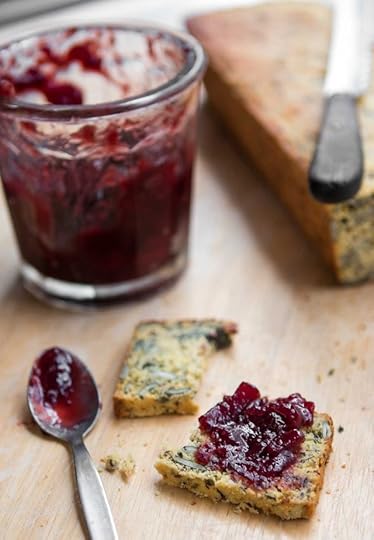David Lebovitz's Blog, page 23
December 23, 2019
Salzburger Nockerl

When I saw the cover of Alpine Cooking, before it came out, it quickly rose to the top of the list of books I needed to get my hands on. I was fortunate to get a preview when I was asked to write a quote for the book jacket, and was thrilled to find the inside of the book was even more compelling than the cover. While it’s hard to compete with the Matterhorn, pictures of locals contemplating a melted cheese sandwich, or a wooden châlet terrace with place settings soon to be heaped with hearty mountain fare, brought the alps right to me.
Covering Italy, Austria, Switzerland, and France, author Meredith Erickson, takes us through cheese caves, ski slopes, restaurants, fondue pots, snow-caked ski boots, and villages, that are all part of the European alps. As Meredith noted in the book, in the winter, if you’re cooking in the alps, there isn’t a lot of fresh produce available in the winter. In fact, there may not be any at all. (Those who live in winter climates, who shop their local farmers market can relate to five months of squash, potatoes, and onions.) So jam fills in.
Continue Reading Salzburger Nockerl...







December 19, 2019
Homemade Orange Bitters

Bitters are used in a number of cocktails. Even if you can’t strongly perceive them while you’re sipping your drink, like salt, lemon zest, and vanilla, bitters are used to balance the flavors in the glass, providing a gentle undernote to bolster or as a contrast to flavors, rather than domineering or taking center stage.
When writing Drinking French* I kept in mind that most people either didn’t have access to a wide variety of bitters, or didn’t want to amass a line-up of little bottles of bitters at home just to make one cocktail. Although sometimes, a certain bitter does make a difference. So a few times, I nudged readers who might want to expand their flavor horizons towards a particular bitter, such as eucalyptus or salted chocolate. But in the overall picture, I like to give choices when writing a recipe in a book, so as many people ca make it as possible.
My fallback bitters are orange and aromatic (Angostura) because I wanted to make sure to use ones that people could easily find. Heck, I’ve even seen Angostura being sold in French supermarkets, as well as at Target stores in the U.S. So there’s really not that much of a barrier to getting your hands on a bottle.
Continue Reading Homemade Orange Bitters...







December 13, 2019
Poilane’s Corn Flour Bread

At some point, we’re all going to have to decide on the same measuring system. Maybe we can make it our New Year’s resolution? Most of the world is using the metric system while a few holdouts, namely the United States, Liberia, and Burma, are sticking with other systems of measurement. For the record, I know some very good bakers that use cups and tablespoons, and I like them as well.
Anyone who says they aren’t accurate hasn’t encountered a French recipe that calls for un verre de vin de lait (a “wine glass” of milk), a cullière à soupe (a soup spoon) of baking powder, or trois feuilles de gélatine, when every sheet of gelatin I’ve come across is either a different size, weight, or strength. And my wine glasses come in a lot of different sizes, too, although I always seem to reach for the largest ones…but not necessarily for baking.

Although books have been written on the subject, my take is that most Americans like holding measuring spoons and cups. It’s more tactile and visceral, kind of like how many of us holdouts don’t want to make dinner in a machine that will make it for us.
Many of us have fond memories of measuring cups, having seen our parents and grandparents using them, and having them handed down to us, but for recipe writers, metrics really are the way to go. The accuracy issue aside, it’s easy to cut a recipe down, say, 20%, which comes in handy when you’re testing a recipe but find that if you could somehow resize the batter down by 20-percent, it’d fit perfectly in a standard cake pan. Otherwise, you’re stuck telling people to use 3/4 cup plus 1 tablespoon of milk, or the 3 tablespoons plus 1/4 teaspoon of heavy cream I saw in a European cookbook that had been translated into English. I don’t know about you, but I’m not measuring out 1/4 teaspoon of cream to make a batch of ice cream.
Continue Reading Poilane’s Corn Flour Bread...







December 11, 2019
Things to do in Paris at Christmas

Hello all, Emily here. There seems to be more and more Christmas activities that are planned in Paris each year, so David asked me to put together a selection of my family’s favorites. Our tree is already up and wherever you are in the world – we’re wishing you a happy holiday season!
Things to do in Paris at Christmas
Without the celebration (and decorations) of Halloween or Thanksgiving in Paris, it is easy to forget the rapid approach of Christmas in France. Decorations don’t tend to go up as in Paris, as they do elsewhere, but when they do arrive, it’s often overnight, and with style. By December 1st, you’ll never be far away from a vendor selling fresh, pine-scented Christmas trees. Wine shops, épicieries (specialty food stores), butchers, and pâtisseries are filled with champagne, gibiers (game), foie gras, macarons, chocolates, and marron glacés (candied chestnuts), as locals stock up for the feasts ahead.
Continue Reading Things to do in Paris at Christmas...







December 8, 2019
Quick Mincemeat recipe

The word Mincemeat doesn’t quite inspire the same rapture that it does in England, most likely due to the name. Meat isn’t something normally associated with dessert in many places (although I had an interesting chocolate and beef pastry in Sicily), but traditional mincemeat is indeed, a wonderful addition to holiday desserts. To make it, one must get suet from a butcher, which posed a challenge for me the first time I made it in France. When I mentioned I needed beef fat to make a dessert to a boucher in Paris, from the look on his face, he wasn’t exactly sure what I was going to make with it. Or, I guess I should say, he wasn’t exactly convinced I was in my right mind. (Which wouldn’t be the first time that happened to me here.)
Not everyone wants to make traditional mincemeat, which is a bit of a chore, but there’s another way to get the wonderful flavors of candied peel, spices, dried fruit, and brandy, in your desserts, and that’s to make quick mincemeat.

Continue Reading Quick Mincemeat recipe...







December 6, 2019
Weekend Links & Holiday Recipes

Winter is just about here. And no, it doesn’t have to suck. True, there’s not much – if any – snow in Paris – which is something I miss. (When we’ve had it, it makes Paris more luminous and pretty.) But there’s no shortage of cold. In addition to being the time to unpack all one’s winter gear, and sadly pack up the t-shirts and sandals, it’s also time to use all those bitter greens, like Belgian endive, chicory, and radicchio, at the markets.
You can make salads out of them, you can roll them up with ham and cheese for a gratin, you can wilt chicorée rouge de trévise (shown above) and toss the leaves with whole wheat pasta, red pepper flakes, garlic, olive oil, and bacon, and you can make risotto with bacon and radicchio or simmer radicchio with farro. Escarole leaves can be the base of an Italian-style soup with beans and meatballs. And by some miracle of nature, they go perfectly well with winter fruits, like oranges, tangerines, and pears. Romain was pretty skeptical when he saw me tossing tangerine segments in a salad of escarole, chives, and Roquefort recently, but the bright-tasting fruits went spectacularly well with the crunchy leaves and creamy/tangy fromage, and now he’s doing it, too.
Otherwise, I’ve been holed up indoors, catching up on Stranger Things; Season 3 is terrific, but I had to abandon Russian Doll after episode 5 since I couldn’t tell where it was going, except around and around. (In spite of my affection for actress/writer Natasha Lyonne.) I’m also reading Stand Facing the Stove, a methodically researched book about Irma Rombauer and her daughter, Marion Rombauer Becker, who wrote the Joy of Cooking with hardly any experience under their apron belts. It’s a pretty deep-dive, documenting the turbulent times the cookbook has been through, so I’m alternating it with reading things on the internet. Here are some of the most interesting things I’ve read recently…
-Dream of working in a Parisian bakery? Sain boulangerie offers three days of classes. Mitigating factor: Classes start at…4:30 am. (I presume coffee is included) (Atelier de Sens)
Continue Reading Weekend Links & Holiday Recipes...







December 2, 2019
The Shaken Martini

It’s funny how two ingredients can inspire so much discussion, conflict, anticipation, one-upmanship, derision, desire, ire, and postulating. Yes, I’m talking about the Martini cocktail. From what kind of gin to use, how much (if any) vermouth is added, whether it’s shaken or stirred, if you should add bitters, and whether an olive or lemon twist is preferred, few seem to agree on what makes a perfect martini. And let’s not forget vodka martinis, espresso martinis, appletinis, Gibsons, dirty martinis, Vespers, etc.
Continue Reading The Shaken Martini...







November 22, 2019
Caramelized Peanut Coffee Cake

Whenever I’m looking through a new cookbook, what never fails to make me bookmark a recipe is when I come across something that has caramelized nuts on it, or in it. Whether it be Honey-Almond Squares or Swedish Almond Cake, you can be sure you’ll find me in my kitchen within the next 24 hours, and baking it. This Caramelized Peanut Cake that takes very little effort to make, but yields big rewards. Big, crunchy, peanutty ones, with a bonus of moist, buttery cake underneath, holding it all together.
Continue Reading Caramelized Peanut Coffee Cake...







November 18, 2019
Cranberry Chutney

Have you ever gone away for a few weeks and found out that you’d left the freezer door ajar? Well, I did. And let me tell you, it wasn’t pretty.
Before traveling, since I’m anti-gaspillage (against food waste), I jammed whatever I could into my already-stuffed freezer, including a half-eaten tomato tart, which I thought would be nice to have ready-and-waiting upon my arrival home, partially-used blocks of butter, and the miscellaneous leftover ends of bread that one collects when one constantly buys too much bread. When I returned, I realized that one of those bread pieces had been caught in the door and kept it from sealing closed.
Continue Reading Cranberry Chutney...







November 12, 2019
Claudia Fleming’s Stout Gingerbread

I could probably name about a dozen people who could be called baking legends. One of them is Claudia Fleming, who was the pastry chef at Gramercy Tavern, and whose book, The Last Course, became a cookbook classic.

Claudia was known for desserts that managed to balance seasonal fruits, as well as chocolate, spices, herbs, grains, and even vegetables, not by using fancy techniques, but by presenting them with contrasting or complementary ingredients. The Last Course is a compilation of some of her best desserts, which came out in 2001. (My copy, above, is a first edition and I’m proud to say I was one of the first people to buy it.) As books do, this one eventually sailed out of print and used copies went for steep prices. I held on to mine, resisting offers to sell it. But I’m happy to report that The Last Course is back in print, and available to all.
Continue Reading Claudia Fleming’s Stout Gingerbread...










